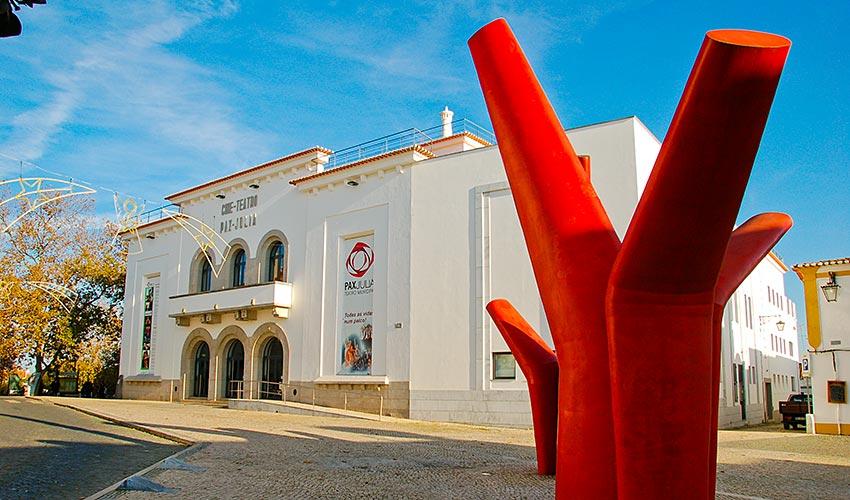Imagine vast, sun-baked plains of golden wheat fields and olive trees where you can drive for miles surrounded only by this natural beauty. Picture reaching dramatic cliffs on the western tip of Europe, where virtually untouched beaches lie on the Atlantic shore. Now envisage charming towns and villages that reflect a long Moorish occupation, with their narrow streets, picturesque whitewashed houses and decorative tiles. As the night settles, a certain calm whispers through the plains of Beja and invites people to rest, as the next day awaits full of sunshine and life. The district of Beja in the region of the Alentejo is all this and much more: ready for you to discover!
Sun-kissed golden shores
Influenced by a Mediterranean and North African climate, Beja is generally warm and dry, providing the perfect weather for those looking for a relaxing holiday by the beach. Young flip flop-clad travellers arrive from all over the country with surf boards in hand, ready to dive into the challenging waves of the ocean. Beach bars play chill-out music which sets the mood for those looking forward to sitting down and enjoying a drink whilst contemplating the sunset in the horizon. During the summer months, enormous concert stages are set up for crowd-gathering music festivals, attracting people of all ages and from all over Europe.
The city of Beja’s enchanting history
The capital of Beja bears the same name as the district. Its history goes back to Roman times when Julius Caesar made the city of Beja the regional capital. The Roman ruins at Pisões are standing proof of the richness of this empire. When the Moors invaded in the 8th Century they designed the cobbled streets and their stunning architecture has been left virtually untouched until today. The castle of Beja exists since Roman times and keeps the memory of Portuguese struggles to conquer this part of the country well alive.
Wander through the streets of Beja and admire the whitewashed houses with colourful borders around their windows and visit the many museums that house relics from the region’s different settlers. Close to the heart of the city, where traditional architecture lives side-by-side with contemporary buildings, is the BejaParque Hotel. This hotel’s four-star accommodation offers contemporary decor and an array of fantastic facilities that will help make your stay unforgettable.
Places to see
Castelo de Beja (Beja Castle)
This castle shows many characteristics of a Portuguese fortification, though its origin dates back to the Roman times. It has been modified and added to throughout the centuries and was mainly used by the Arabs as a defence position against the Portuguese who finally re-conquered Beja in the 13th Century. The Keep, one of the castle’s most beautiful features, was ordered to be built by King Dinis in 1310 and it is considered one of the most important examples of medieval architecture in Portugal.
Ruínas Romanas de Pisões (Roman Ruins at Pisões)
Situated in the Herdade da Almagrassa, around 6.2 miles (10 kilometres) away from the city of Beja, are the Roman ruins of Pisões. The excavations unveiled a large Roman villa with over forty different rooms, with rich decorative elements found on the floors and on its walls. A tank, pool and thermal baths also existed near this house and it serves as one of the best examples of private Roman baths in the country.
Estação das Mesas do Castelinho (Mesas do Castelinho Archaelogical Site) – Almodôvar
The archaeological site known as Mesas do Castelinho, is located in the Monte Novo do Castelinho property. It’s a large fortified village that is believed to date from Portugal’s 2nd Iron Age.
Igreja Matriz de Castro Verde (Castro Verde’s Main Parish Church) – Castro Verde
Castro Verde’s Main Parish Church, the Royal Basilica, honours King D. Sebastião’s crossing through the village in 1573. The interior, covered with 17th Century-tiled panels, portrays one of the most legendary battles in Portuguese history, the Battle of Ourique.
Calvário das Pedras Negras (Black Stone Calvary) – Ferreira do Alentejo
This is a small church with a unique kind of architecture. The outside walls of its cylindrical structure are covered with built-in black stones. These represent the biblical version of the Hebrews throwing stones at Jesus as he made his way to the cross. This Church, considered the most important monument of Ferreira do Alentejo, was rebuilt in the 19th Century.
Recommended Beja Hotels
BejaParque Hotel

 English
English  Português
Português  Deutsch
Deutsch 



